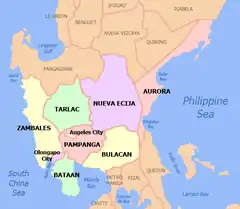Baliuag
The municipality of Baliwag (Tagalog: Bayan ng Baliwag), is a 1st class municipality in the province of Bulacan, Philippines. According to the 2015 census, it has a population of 149,954 people. [4]
Baliwag
Baliwág | |
|---|---|
| Municipality of Baliwag | |
 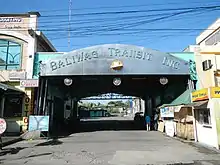    (From top, left to right): Baliuag Museum and Library (Old Town Hall) • Baliwag Transit terminal • Baliwag Clock Tower overviewing the Baliwag Wet and Dry Market • Mariano Ponce house birthplace marker • St. Augustine Parish Church (Baliuag) | |
 Flag  Seal | |
| Nickname(s): Buntal Hat Capital of the Philippines | |
| Motto(s): Dugong Baliwag, Pusong Baliwag (English: Baliwag by blood, Baliwag in my heart) | |
 Map of Bulacan with Baliuag highlighted | |
OpenStreetMap 
| |
.svg.png.webp) Baliwag Location within the Philippines | |
| Coordinates: 14°57′N 120°54′E | |
| Country | |
| Region | Central Luzon (Region III) |
| Province | Bulacan |
| District | 2nd District |
| Founded | May 26, 1733 [1] |
| Barangays | 27 (see Barangays) |
| Government | |
| • Type | Sangguniang Bayan |
| • Mayor | Ferdinand Estrella (PDP–Laban) |
| • Vice Mayor | Christopher F. Clemente (NUP) |
| • Representative | Gavini C. Pancho |
| • Electorate | 101,946 voters (2019) |
| Area | |
| • Total | 45.05 km2 (17.39 sq mi) |
| Elevation | 18 m (59 ft) |
| Population | |
| • Total | 149,954 |
| • Rank | 19 out of 1,489 Municipalities |
| • Density | 3,300/km2 (8,600/sq mi) |
| • Households | 35,488 |
| Demonyms | Baliuageño (male) Baliuageña (female) Baliuagenean |
| Economy | |
| • Income class | 1st municipal income class |
| • Poverty incidence | 5.37% (2015)[5] |
| • Revenue | |
| • Assets | |
| • Expenditure | |
| Utilities | |
| • Electricity | MERALCO |
| Time zone | UTC+8 (PST) |
| ZIP code | 3006 |
| PSGC | |
| IDD : area code | +63 (0)44 |
| Climate type | tropical monsoon climate |
| Native languages | Tagalog Kapampangan |
Baliwag was founded in 1732 by Augustinian friars and was incorporated by the Spanish Governor-General on May 26, 1733. The town was a part of Quingua (now Plaridel) before.
Through the years of Spanish domination, Baliwag was predominantly agricultural. People had to depend on rice farming for the main source of livelihood. Orchards and tumanas yielded fruits and vegetables, which were sold in the public market. Commerce and industry also played important contributions to the economy of the people. Buntal hat weaving in Baliwag together with silk weaving popularly known in the world as Thai silk; the manufacturer of cigar cases, piña fibers, petates (mats), and Sillas de Bejucos (cane chairs) all of the fine quality became known in many parts of the world. The local market also grew. During the early part of the 19th century, Baliwag was already considered one of the most progressive and richest towns in Bulacan. The growth of the public market has significantly changed the model of the economy of the town.
Baliwag is the major commerce, transportation, entertainment, and educational center of Northern Bulacan. With the continuous expansion of Metro Manila, the municipality is now part of Manila's built-up area which reaches San Ildefonso in its northernmost part.
History
Fr. Joaquín Martínez de Zúñiga, OSA, a friar, in his "1803 Historia de las Islas Filipinas"[7] wrote that the Convent or Parochial house of San Agustin, in Baliwag, is the best in the whole Archipelago and that no edifice in Manila can be compared to it in symmetry and beauty amid its towering belfry, having been a viewing point of the town's panorama. The frayle further stated that the Convent was a repository of priceless parish records that dated to the founding of Baliwag as a pueblo or parrochia by the OSA or Augustinians in 1733. But the first convent was erected at Barangay Santa Barbara, Baliuag before the Parokya was formally established at the now Plaza Naning, Poblacion.

Fr. Joaquín Martínez de Zúñiga arrived in the Philippines on August 3, 1786 and visited Baliwag on February 17, 1802 with Ignacio Maria de Álava y Sáenz de Navarrete. Their host was Baliwag's Parish Priest, Fray Esteban Diez Hidalgo.[8] Fr. Diez served as the longest cura parroco of Baliwag from 1789, having built the church and convent from 1790 to 1801.
Spanish records "Apuntes históricos de la provincia augustiniana del Santísimo Nombre de Jesús de Filipinas"[9] reveal that Fr. Juan de Albarran, OSA was assigned Parish Priest of Baliwag in 1733. The first baptism in Baliwag Church was ordered by Fr. Lector and Fr. Feliz Trillo, Provincial of the Province on June 7, 1933 while Baliwag was founded and began its de jure existence on May 26, 1733. The pueblo or town was created in the provincial Chapter on May 15, 1734, with the appointment of Fr. Manuel Bazeta/Baseta as first cura parroco.[10]
In 1769-1774, the Church of Baliwag was built by Father Gregorio Giner. The present structure (the third church to be rebuilt, due to considerable damage during the 1880 Luzon earthquakes) was later rebuilt by Father Esteban Diaz using mortar and stone. The 1866 Belfry was also completed by Father Matias Novoa but the July 19, 1880 quake damaged the same which was later repaired by Father Thomas Gresa.[11][12]
The earthquake of June 3, 1863, one of the strongest to ever hit Manila, destroyed the Governor's Palace in Intramuros. Malacañang then became the permanent residence of the head of the country. The massive quake also damaged the Baliwag Church.[13] In 1870, the reconstruction began when a temporary house of worship, the “Provincial”, along Año 1733 street, emerged as a narrow, and simple edifice which later used by the RVM Sisters of the Colegio de la Sagrada Familia (now St. Mary's College of Baliuag) as the classroom. Antonio de Mesa, “Maestrong Tonio" fabricated the parts to have finished the Spanish-era Baliwag Church.
First Municipio
Baliwag had 30 curates (1733–1898): Fr. Esteban Diez Hidalgo and Fr. Fausto Lopez served 40 and 24 years, respectively. Fr. Lopez had 6 children with a beautiful native, Mariquita: Dr. Joaquin Gonzalez, Francisco, the former Assemblyman Ricardo Lloret Gonzales (Legislative districts of Bulacan, 5th Philippine Legislature), and Jose the eldest who was widely known as “Pepeng Mariquita", inter alia. Spanish cura parroco, Fr. Ysidoro Prada served in Baliwag during the last decade of the Spaniard regime.
The Philippine-American civil and military authorities supervised the first municipal elections, having chosen Baliwag as the site of the first Philippine elections of May 7, 1899.[14] The Filipinos gathered at the plaza of the St. Augustine Church after the Holy Mass, and thereafter the officials were selected based on the qualifications for voters set by the Americans.[15]
The first town Gobernadorcillo (1789 title) of Baliwag was Cap. Jose de Guzman.[16] He was assisted by the Tribunal's teniente mayor (chief lieutenant), juez de ganadas (judge of the cattle), juez de sementeras (judge of the field) and juez de policia (judge of the police). In the History of the Philippines (1521–1898), the 1893 Maura Law, the title of Gobernadorcillo became "capitan municipal" and that of each juez to teniente. From Baliwag's independence from Quingua, now Plaridel, Bulacan to 1898, 49 served as capitan, 13 alcalde and 92 as Gobernadorcillo. Felix de Lara (1782) and Agustin de Castro (1789) were the 1st alcalde and Gobernadorcillo, respectively. Municipal President Fernando Enrile, in 1908, honored some of these officials, even naming some of Baliuag calles in their honor, later. But all these political officials remained under the thumbs and the habito, of the autocratic Augustinian friars, the Baliwag Kura Parokos.
The local government of Baliwag used as first Municipio under the American regime (History of the Philippines (1898–1946)) the Mariano Yoyongko (Gobernadorcillo in 1885) Principalia in Poblacion (now a part of the market site), which it bought from Yoyongko.[17]
On September 15, 1915, Baliwag municipality bought the heritage mansion and a lot of Dr. Joaquin Gonzalez. The Gonzalez old mansion served as Lumang Municipio (the Old Municipio or Town Hall Building, as the seat of the local government) for 65 years. It is now the Baliuag Museum and Library.
Baliwag produced not less than 30 priests, including 3 during the Spanish-Dominican, and 2 Jesuits during the American regimes.
Jeorge Allan R. Tengco and Amy R. Tengco (wife of Lito S. Tengco), philanthropists, owners of Baliwag Transit and other chains of business establishments had been conferred the Papal Orders of Chivalry October 3, 2000 Pro Ecclesia et Pontifice and the 2012 Dame of the Order of St. Gregory the Great awards.[18]
Don Mariano Ponce
Mariano Ponce was a native of Baliwag. He was a founding member of the Propaganda Movement together with José Rizal and Marcelo del Pilar; a former assemblyman of the second district of Bulacan to the Philippine Assembly; and the co-founder of La Solidaridad with fellow co-founder Graciano López-Jaena. His most common names are Naning (the Plaza Naning in Baliwag being named after his nickname); Kalipulako, named after the Cebuano hero Lapu-Lapu; and Tagibalang or Tigbalang (Tikbalang), a supernatural being in Filipino folklore.[19]
Proposed cityhood
In 2018, the Sangguniang Bayan filed a resolution to request Bulacan 2nd District Representative Gavini Pancho, to file a house bill to convert Baliwag into a city.[20]
In 2020, ACT-CIS Partylist Representative Eric Go Yap and 1st District of Davao City Representative Paolo Duterte filed House Bill 7362, seeking to convert Baliwag into a city in the province.[21]
Barangays
Baliwag is politically subdivided into 27 barangays.
| PSGC | Barangay | Population | ±% p.a. | |||
|---|---|---|---|---|---|---|
| 2015 [4] | 2010 [22] | |||||
| 031403001 | Bagong Nayon | 3.7% | 5,616 | 5,994 | −1.23% | |
| 031403002 | Barangca | 2.0% | 3,051 | 2,742 | 2.05% | |
| 031403003 | Calantipay | 1.9% | 2,784 | 2,613 | 1.21% | |
| 031403004 | Catulinan | 1.3% | 1,916 | 1,769 | 1.53% | |
| 031403005 | Concepcion | 6.6% | 9,933 | 9,585 | 0.68% | |
| 031403006 | Hinukay | 1.4% | 2,140 | 1,419 | 8.14% | |
| 031403007 | Makinabang | 7.8% | 11,715 | 11,196 | 0.87% | |
| 031403008 | Matangtubig | 1.8% | 2,630 | 2,859 | −1.58% | |
| 031403010 | Pagala | 2.6% | 3,843 | 3,139 | 3.93% | |
| 031403011 | Paitan | 1.0% | 1,517 | 1,440 | 1.00% | |
| 031403012 | Piel | 1.5% | 2,229 | 1,955 | 2.53% | |
| 031403013 | Pinagbarilan | 3.6% | 5,357 | 5,178 | 0.65% | |
| 031403014 | Poblacion. | 6.3% | 9,448 | 9,668 | −0.44% | |
| 031403016 | Sabang | 7.6% | 11,350 | 11,960 | −0.99% | |
| 031403017 | San Jose | 4.4% | 6,575 | 5,346 | 4.02% | |
| 031403018 | San Roque | 2.4% | 3,554 | 3,402 | 0.84% | |
| 031403019 | Santa Barbara | 7.8% | 11,676 | 11,568 | 0.18% | |
| 031403020 | Santo Cristo | 5.9% | 8,840 | 8,650 | 0.41% | |
| 031403021 | Santo Niño | 2.5% | 3,818 | 3,470 | 1.84% | |
| 031403022 | Subic | 3.7% | 5,506 | 4,550 | 3.70% | |
| 031403023 | Sulivan | 3.4% | 5,070 | 4,776 | 1.14% | |
| 031403024 | Tangos | 3.8% | 5,699 | 5,578 | 0.41% | |
| 031403025 | Tarcan | 4.9% | 7,333 | 6,892 | 1.19% | |
| 031403026 | Tiaong | 3.3% | 5,006 | 4,903 | 0.40% | |
| 031403027 | Tibag | 2.0% | 3,014 | 3,746 | −4.06% | |
| 031403028 | Tilapayong | 2.3% | 3,389 | 2,494 | 6.01% | |
| 031403030 | Virgen delas Flores | 4.6% | 6,945 | 6,673 | 0.76% | |
| Total | 149,954 | 143,565 | 0.83% | |||
Climate
| Climate data for Baliuag, Bulacan | |||||||||||||
|---|---|---|---|---|---|---|---|---|---|---|---|---|---|
| Month | Jan | Feb | Mar | Apr | May | Jun | Jul | Aug | Sep | Oct | Nov | Dec | Year |
| Average high °C (°F) | 28 (82) |
29 (84) |
31 (88) |
33 (91) |
32 (90) |
31 (88) |
30 (86) |
29 (84) |
29 (84) |
30 (86) |
30 (86) |
28 (82) |
30 (86) |
| Average low °C (°F) | 20 (68) |
20 (68) |
21 (70) |
22 (72) |
24 (75) |
24 (75) |
24 (75) |
24 (75) |
24 (75) |
23 (73) |
22 (72) |
21 (70) |
22 (72) |
| Average precipitation mm (inches) | 6 (0.2) |
4 (0.2) |
6 (0.2) |
17 (0.7) |
82 (3.2) |
122 (4.8) |
151 (5.9) |
123 (4.8) |
124 (4.9) |
99 (3.9) |
37 (1.5) |
21 (0.8) |
792 (31.1) |
| Average rainy days | 3.3 | 2.5 | 11.7 | 6.6 | 17.7 | 22.2 | 25.2 | 23.7 | 23.2 | 17.9 | 9.2 | 5.2 | 168.4 |
| Source: Meteoblue [23] | |||||||||||||
Demographics
|
|
| |||||||||||||||||||||||||||||||||||||||||||||||||||
| Source: Philippine Statistics Authority [4] [22] [24][25] | |||||||||||||||||||||||||||||||||||||||||||||||||||||
In the 2015 census, the population of Baliwag, Bulacan, was 149,954 people, [4] with a density of 3,300 inhabitants per square kilometre or 8,500 inhabitants per square mile.
Religion
Baliwag at present has six parishes, a sub-parish and a quasi-parish under the administration of Diocese of Malolos. Their patron saint of Baliuag is St. Augustine because Baliwag was founded by the Augustinians in 1733.
Economy
   | |
Major industries
- Garments
- Pyrotechnics
- Food/Food Processing
- Furniture
- Swine
- Chicken Production
- Automobile Industry
Major products
- Buntal Hat and Bags
- Bakeries (Native Pandesal, Ensaymada, Spanish Bread)
- Native Delicacies (Chicharon, Puto, Pastillas de Leche)
- Lechon Manok (famously Baliuag Lechon Manok)
Malls & supermarkets
- SM City Baliwag
- A Square
- Puregold Baliwag
- Super8 Grocery Warehouse
- Puregold DRT Highway
- Puregold Tangos
- Savemore Supermarket
- Ultra Mega Supermarket
- Unitop Baliwag
- Waltermart Mall Baliwag (U/C)
- NSN (U/C)
- RCS (U/C)
Local government
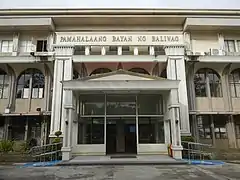
| Position | Name | Party | |
|---|---|---|---|
| Mayor | Ferdinand "Ferdie" V. Estrella | PDP–Laban | |
| Vice Mayor | Christopher "Cris" F. Clemente | NUP | |
| Councilors | Marie Claudette "Madette" S. Quimpo | NUP | |
| Enrique "Buko" dela Cruz, Jr. | Independent | ||
| Lee Edward "Dingdong" V. Nicolas | PDP–Laban | ||
| Maria Isabel "Mabel" L. Pascual | NUP | ||
| Wilfredo "Willy" Lapira | NUP | ||
| Lowell C. Tagle | PDP–Laban | ||
| Antonio "Tony" Patawaran | PDP–Laban | ||
| Rodrigo "Ogie" Baltazar | PDP–Laban | ||
| Ex Officio Municipal Council Members | |||
| ABC President | Ricky Romulo (Tiaong) | Nonpartisan | |
| SK Federation President | Jaime Viceo IV (Santa Barbara) | Nonpartisan | |
List of former mayors
| No. | Presidente Municipal | Took office | Left office |
|---|---|---|---|
| 1 | Francisco Guerrero | 1899 | 1899 |
| 2 | Jose Rustia | 1900 | 1900 |
| 3 | Ancieto Valencia | 1901 | 1903 |
| 4 | Dr. Domingo M. Enrile | 1904 | 1905 |
| 5 | Jose Lajom | 1906 | 1907 |
| 6 | Fernando Enrile | 1908 | 1909 |
| 7 | Martin H. Prado | 1910 | 1912 |
| 8 | Juan Racelis | 1913 | 1918 |
| 9 | Pablo Camacho | 1919 | 1922 |
| 10 | Emilio Rustia | 1922 | 1925 |
| 11 | Pedro R. Mateo | 1925 | 1930 |
| 12 | Dr. Peregrino E. Sauco | 1931 | 1934 |
| 13 | Atty. Wenceslao Ortega | 1934 | 1937 |
| No. | Alcalde | Took office | Left office |
| 1 | Dr. Guilermo dela Merced | 1938 | 1941 |
| 2 | Rafael Chico | 1942 | 1945 |
| No. | Municipal Mayors | Took office | Left office |
| 1 | Maj. Servando C. Santos | 1946 | 1955 |
| 2 | Roberto E. Chico | 1956 | 1959 |
| 3 | Felix Tiongson | 1960 | 1963 |
| 4 | Roberto E. Chico | 1964 | 1967 |
| 5 | Florentino Vergel de Dios | 1968 | 1980 |
| 6 | Dominador Enrile | 1980 | 1981 |
| 7 | Leonardo C. Mananghaya | 1981 | 1986 |
| 8 | Atty. Emilio Camacho Santos (OIC) | 1986 | 1988 |
| 9 | Reynaldo S. del Rosario | 1988 | 1992 |
| 10 | Cornelio P. Trinidad | 1992 | 1994 |
| 11 | Edilberto S. Tengco | 1994 | 1998 |
| 12 | Rolando F. Salvador | 1998 | 2004 |
| 13 | Romeo M. Estrella | 2004 | 2013 |
| 14 | Carolina L. Dellosa, M.D | 2013 | 2016 |
| 15 | Ferdinand V. Estrella | 2016 | incumbent |
Attractions
- Baliwag Clock Tower
- Baliwag is the home of the first self-supporting clock tower in Bulacan, which is a heritage attraction in the town.
- Lenten Processions
- Baliwag is known for its Semana Santa (Holy Week) processions, which are among the longest religious processions in the Philippines. As of 2019, the procession hosts a record 124 (121, with 3 additional) carros Early versions of the buntal hat were wide-brimmed farmer's hats and used unsoftened strips of buntal fiber. The industry expanded into Baliwag, Bulacan between 1907 to 1909, originally introduced by Mariano Deveza who originally hailed from Lucban, Quezon. or carrozas (floats) with life-sized santos (statues) joined in the parade showcasing events from the life and passion of Christ.
- Buntal Hat Festival
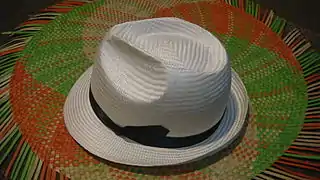 A buntal hat from Baliuag
A buntal hat from Baliuag
Buntal Hat Festival is a celebration of the culture of buntal hat making in the town that is simultaneously celebrated with Mother's Day annually. Early versions of the buntal hat were wide-brimmed farmer's hats and used unsoftened strips of buntal fiber. The industry expanded into Baliwag, Bulacan between 1907 to 1909, originally introduced by Mariano Deveza who originally hailed from Lucban, Quezon. Colorful and grandiose decorations and street dancing are the highlights of this celebration.
Other attractions
- 3006 Augustine Square (A. Square)
- Baliuag Glorietta Park
- Baliuag Museum and Library (Lumang Municipio)
- Mariano Ponce Ancestral House Museum
- The Greenery Events Place
- The Baliwag Star Arena
- Jose Rizal Monument at Plaza Naning
- Baliwag Pasalubong Center
- Parish Museum of Old Religious Artifacts (Parish of St. Augustine)
- Carozza Makers
- Artisan Street (Bone In-Lay Handicrafts)
- Baliwag Heroes’ Park
- Baliwag Night Market
- Baliwag Christmas Night Market
- The Chapters
Transportation

Public transportation in Baliwag is served by provincial buses, jeepneys, UV Express AUVs, and intra-municipal tricycles.
Baliwag Transit, Inc., one of the largest bus transportation system in the Philippines, is headquartered in Barangay Sabang. It mainly services routes to and from Metro Manila and Central Luzon.
There are three (3) major transport lines in the municipality: The Baliwag-Candaba (Benigno S. Aquino Avenue) road going to Pampanga (from the Downtown Baliwag to Candaba Town Proper), the Old Cagayan Valley road (Calle Rizal) and the Dona Remedios Trinidad Highway (N1, AH26) going to Manila and Nueva Ecija. The town is located 52 kilometers north of Manila, the capital of the Philippines.
Education
There are public and private educational institutions found in Baliwag.
Tertiary Education
- Baliuag University – is the first school granted full autonomy in Region III by the Commission on Higher Education (CHED) in 2001.
- Baliuag Polytechnic College – is a public tertiary and vocational education institution in Baliwag.
- Fernandez College of Arts and Technology
- St. Mary's College of Baliuag – is a co-ed (mixed-sex) Catholic school founded in 1912 and administered by the Religious of the Virgin Mary, the first pontifically approved congregation for women in the Philippines.
- STI College
- ACLC
- Marian College Of Baliuag
- National University - Baliuag
Primary and Secondary Education
Here are some of the school's offers between primary and secondary education;
Public
- Mariano Ponce National High School
- Sto. Niño High School
- Virgen Delos Flores High School
- Sulivan High School
- Teodoro Evangelista Memorial High School (a school between Baliuag and Bustos)
- Tilapayong Elementary School
- San Jose Elementary School
- Concepcion Elementary School
- Sabang Elementary School
- Baliuag North Central School
- Baliuag South Central School
- Catulinan Elementary School
Private
- Montessori De Sagrada Familia is a private basic education school established in late-1997, known for its state of the art learning and sports facilities.
- Living Angeles Christian School is a private basic education school established in early-1997 known for good facilities and near SM City Baliuag.
- The Catholic Servants of Christ Community is also a private basic education school established in 2002 and is located in Sulivan, Baliwag, Bulacan.
Gallery
 Baliwag Welcome Arch from Pulilan, Bulacan
Baliwag Welcome Arch from Pulilan, Bulacan Baliwag Clock tower
Baliwag Clock tower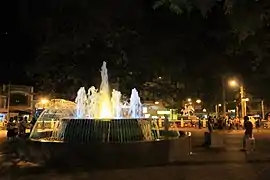 Baliwag Glorietta Park at night
Baliwag Glorietta Park at night Ang Baliwag kay Rizal Monument
Ang Baliwag kay Rizal Monument Baliwag Star Arena
Baliwag Star Arena Baliwag District Hospital
Baliwag District Hospital
See also
- Good Friday processions in Baliuag
- St. Augustine Parish Church of Baliuag
- Baliuag Museum and Library
- Sub-Parish Church of Santo Cristo
- Lady of Most Holy Rosary Parish Church
- Fernandez College of Arts and Technology
- Baliuag University
- St. Mary's College of Baliuag
- Baliwag Transit
- SM City Baliuag
- OLM Institute & Skills Training Center for Allied Courses Inc.
- Dr. Joaquin Gonzalez
References
- https://m.facebook.com/story.php?story_fbid=762875027066434&id=162440863776523
- Municipality of Baliuag | (DILG)
- "Province: Bulacan". PSGC Interactive. Quezon City, Philippines: Philippine Statistics Authority. Retrieved 12 November 2016.
- Census of Population (2015). "Region III (Central Luzon)". Total Population by Province, City, Municipality and Barangay. PSA. Retrieved 20 June 2016.
- "PSA releases the 2015 Municipal and City Level Poverty Estimates". Quezon City, Philippines. Retrieved 1 January 2020.
- ""Commission on Audit 2017 Report-Bulacan"". Quezon City, Philippines: Commission on Audit. Retrieved 8 July 2018.
- MARTINEZ de ZUÑIGA OSA, Fr Joaquín (1803). Historia de las Islas Philipinas (2 vols) (in Spanish). Sampaloc: Impreso por Fr. Pedro Argüelles de la Concepción. OCLC 30062450.
- "Archived copy". Archived from the original on 2013-10-12. Retrieved 2013-03-30.CS1 maint: archived copy as title (link)
- "Apuntes históricos de la provincia augustiniana del Santísimo Nombre de Jesús de Filipinas : a... - National Library of Australia". nla.gov.au. Retrieved 24 June 2015.
- "Protected Blog". wordpress.com. Retrieved 24 June 2015.
- "Visita Iglesia: The old churches of Bulacan, Part 1 of 2". Simbahan. Retrieved 24 June 2015.
- Malacañang Palace#Etymology
- Balabo, Dino (2007-05-07). "Baliuag marks 108 years of town elections". The Philippine Star. Retrieved 2012-12-31.
- "Baliuag marks 108 years of town elections". The Philippine Star. Retrieved 24 June 2015.
- "Archived copy". Archived from the original on 2013-10-12. Retrieved 2013-01-07.CS1 maint: archived copy as title (link)
- "Multiply.com". multiply.com. Archived from the original on 2016-03-04. Retrieved 24 June 2015.
- "Archived copy". Archived from the original on 2011-01-03. Retrieved 2011-01-12.CS1 maint: archived copy as title (link)
- "Mariano Ponce". Official Website of the Provincial Government of Bulacan. Retrieved 29 June 2018.
- "Mayor Ferdie, SB, 27 Kapitan, SK, at Sectoral Groups, Pormal na isinalin ang Cityhood Documents kay Cong. Apol Pancho". Baliwag News Online. August 1, 2018. Retrieved September 24, 2020.
- "Measure converting Baliwag town into a city up in Congress". Philippines Graphic. September 12, 2020. Retrieved September 24, 2020.
- Census of Population and Housing (2010). "Region III (Central Luzon)". Total Population by Province, City, Municipality and Barangay. NSO. Retrieved 29 June 2016.
- "Baliuag: Average Temperatures and Rainfall". Meteoblue. Retrieved 12 May 2020.
- Censuses of Population (1903–2007). "Region III (Central Luzon)". Table 1. Population Enumerated in Various Censuses by Province/Highly Urbanized City: 1903 to 2007. NSO.
- "Province of Bulacan". Municipality Population Data. Local Water Utilities Administration Research Division. Retrieved 17 December 2016.
- ""Commission on Audit Financial Report 2016-Baliwag"". Quezon City, Philippines: Commission on Audit (COA). Retrieved 29 June 2018.
- ""Municipal Officials-Baliwag"". City of Malolos, Bulacan: Provincial Government of Bulacan Official Website. Retrieved 29 June 2018.
- ""Sangguniang Kabataan, Sumasailalim sa Pagsasanay. SK Chair Jaime Viceo IV ng Santa Barbara nahalal na SK Federation President."". Baliwag, Bulacan: Baliwag City News Online. Retrieved 29 June 2018.
External links
| Wikimedia Commons has media related to Baliuag, Bulacan. |
| Wikivoyage has a travel guide for Baliuag. |
